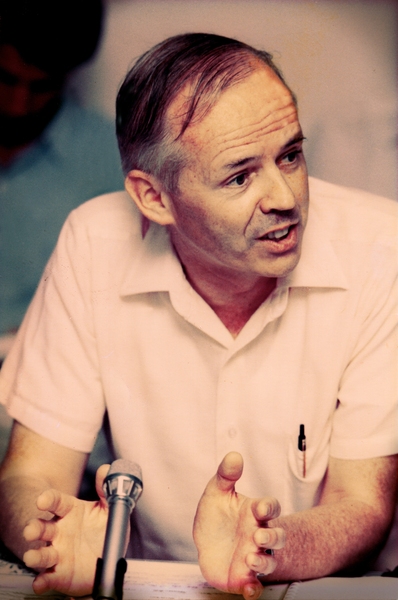Jean Pierre de Monchaux, an idealistic and optimistic planner and architect who served as dean of the MIT School of Architecture and Planning from 1981 to 1992, passed away on April 30, after living with Parkinson’s disease for 20 years. He was 81.
De Monchaux, also known as John, came to MIT after many years’ professional experience in the United States, the United Kingdom, South America, Australia, and Southeast Asia. His international upbringing in Dublin, Montréal, New York City, Bogotá, Sydney, and London produced lasting memories of life onboard the ocean liners and tramp steamers that ferried him between these places as a boy and young man.
His diverse background informed his vision of urban planning as a conciliatory practice of listening and learning between constituencies and professionals. He understood all of the world’s cities as neighborhoods of a single global village — as shared places of possibility, and of messy meaning, that transcended false notions of order and border.
“John’s legacy is all around us,” says Hashim Sarkis, dean of the School of Architecture and Planning. “His influence is reflected every day through our classes and research, in our passion to serve the world, and in the thoughtful, caring, and supportive community that is a hallmark of SA+P.”
As dean, de Monchaux was known for his ability to nurture dialogue, to forge consensus, and to build bridges between SA+P and other schools at the Institute. He achieved major milestones in the school’s history, including the completion of the award-winning Rotch Library extension in Building 7, the establishment of the Center for Real Estate (the first program of its kind in the United States), and the opening — in the newly-designed I.M. Pei building — of the Media Lab, an endeavor that de Monchaux was proud to have named after many wordier and narrower possibilities were considered.
After stepping down as dean in 1992, de Monchaux took a four-year partial leave from MIT to serve as general manager of the Aga Khan Trust for Culture, a Geneva-based foundation concerned with architecture and urban design as a catalyst for cultural and social development in the Muslim world.
In 1996, he returned to MIT and spent the next dozen years teaching in two departments: Urban Studies and Planning and Architecture. From 1996 until 2004, he served as head of the Special Program in Urban Regional Studies (SPURS), a one-year program designed for mid-career professionals from developing countries.
“He helped many of us, faculty and students alike, to design better cities,” says DUSP department head Eran Ben-Joseph, who worked with de Monchaux in the department. “He was a true friend, mentor, and colleague — a person of genuine integrity, great wisdom, and a gentle soul who will be sorely missed.”
De Monchaux was also a dedicated presence in the Boston design community, serving on the boards of the Boston Society of Architects and the Boston Architectural College, and founding the Boston Civic Design Commission as well as serving as its first chair. He was a trustee of the Boston Foundation for Architecture, and a trustee and overseer of the Museum of Fine Arts, Boston.
Born in Dublin, Ireland, to a French-Australian family, de Monchaux was educated at St John’s College of the University of Sydney in Australia, and at the Harvard University Graduate School of Design, where later, in 1971, he would become a member of that school’s second class of Loeb Fellows. He began his teaching career at the Bartlett School of Architecture at University College, London, in 1964, the beginning of what would become a long collaboration with then-professor Lord Richard Llewellyn-Davies.
De Monchaux had been admitted to MIT’s bachelor’s in architecture program in 1954 from Stuyvesant High School in New York City, but was unable to afford the tuition and enroll as a student. He returned to MIT in 1981 with a particular dedication to opening the Institute’s doors ever wider.
With his wife, British sociologist Suzanne de Monchaux, as part of the design team, he was principal planner for Milton Keynes, a new city in Buckinghamshire, England, that was conceived in the late 1960s as the crowning achievement of Great Britain’s utopian postwar New Towns Movement. In more than two decades of practice as a planner, primarily with global planning partnership Llewellyn Davies and its successor firms, he played a leading role in advocacy design assistance in Watts, Detroit, and Chicago. He also participated in urban plans and environmental impact studies throughout Australia, China, the Middle East, and Southeast Asia, with a particular interest in the developing world, vernacular typologies, and informal urbanisms.
De Monchaux is survived by his twin sons: Nicholas de Monchaux, an associate professor of architecture and urban design at the University of California at Berkeley and a founding partner of the interdisciplinary architecture firm modem; and Thomas de Monchaux, an author, designer, and adjunct assistant professor of architecture at Columbia University.
For a story published in 2007 in PLAN on the occasion of de Monchaux’s nominal retirement from teaching, Lois Craig, who served as associate dean, recalled, “He had a method of getting agreement from people, forming friendships and professional alliances that supported his policies. He created a sense of functional togetherness. He was a conciliator and an enabler, bringing people together.”
In that same article, Professor Julian Beinart, who co-taught many urban design studios with de Monchaux, reflected on his colleague’s studio technique: “John always took the epistemologically cool position: Let’s think about your proposition, let’s untie the knots of your argument, to the extent we can, let’s see if we can reframe some of the parts, let’s see where that takes us.”
A memorial service will be held at 9:30 a.m. on Saturday, Sept. 29, in the MIT Chapel.






